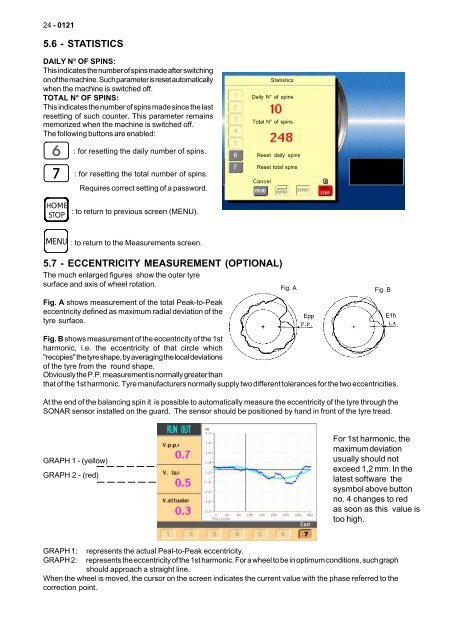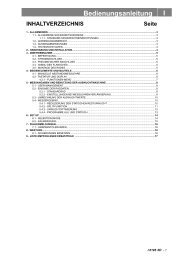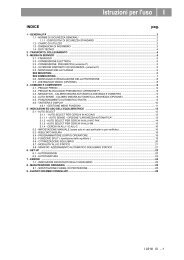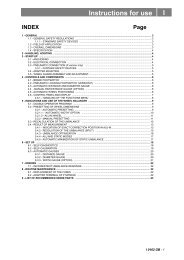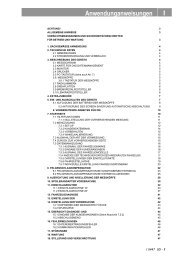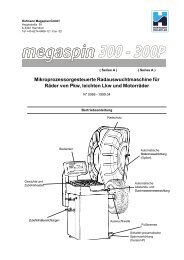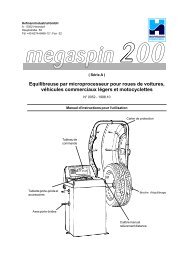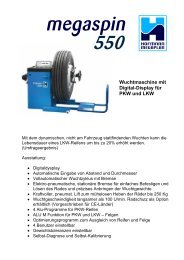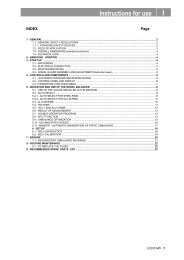4 - Hofmann Megaplan
4 - Hofmann Megaplan
4 - Hofmann Megaplan
Create successful ePaper yourself
Turn your PDF publications into a flip-book with our unique Google optimized e-Paper software.
24 - 0121<br />
5.6 - STATISTICS<br />
DAILY N° OF SPINS:<br />
This indicates the number of spins made after switching<br />
on of the machine. Such parameter is reset automatically<br />
when the machine is switched off.<br />
TOTAL N° OF SPINS:<br />
This indicates the number of spins made since the last<br />
resetting of such counter. This parameter remains<br />
memorized when the machine is switched off.<br />
The following buttons are enabled:<br />
: for resetting the daily number of spins.<br />
: for resetting the total number of spins.<br />
Requires correct setting of a password.<br />
Statistics<br />
Daily N° of spins<br />
Total N° of spins<br />
Reset daily spins<br />
Reset total spins<br />
Cancel<br />
HOME<br />
STOP<br />
: to return to previous screen (MENU).<br />
MENU : to return to the Measurements screen.<br />
5.7 - ECCENTRICITY MEASUREMENT (OPTIONAL)<br />
The much enlarged figures show the outer tyre<br />
surface and axis of wheel rotation.<br />
Fig. A shows measurement of the total Peak-to-Peak<br />
eccentricity defined as maximum radial deviation of the<br />
tyre surface.<br />
Fig. A<br />
Epp<br />
Fig. B<br />
E1h<br />
Fig. B shows measurement of the eccentricity of the 1st<br />
harmonic, i.e. the eccentricity of that circle which<br />
"recopies" the tyre shape, by averaging the local deviations<br />
of the tyre from the round shape.<br />
Obviously the P.P. measurement is normally greater than<br />
that of the 1st harmonic. Tyre manufacturers normally supply two different tolerances for the two eccentricities.<br />
At the end of the balancing spin it is possible to automatically measure the eccentricity of the tyre through the<br />
SONAR sensor installed on the guard. The sensor should be positioned by hand in front of the tyre tread.<br />
GRAPH 1 - (yellow)<br />
GRAPH 2 - (red)<br />
For 1st harmonic, the<br />
maximum deviation<br />
usually should not<br />
exceed 1,2 mm. In the<br />
latest software the<br />
sysmbol above button<br />
no. 4 changes to red<br />
as soon as this value is<br />
too high.<br />
GRAPH 1:<br />
GRAPH 2:<br />
represents the actual Peal-to-Peak eccentricity.<br />
represents the eccentricity of the 1st harmonic. For a wheel to be in optimum conditions, such graph<br />
should approach a straight line.<br />
When the wheel is moved, the cursor on the screen indicates the current value with the phase referred to the<br />
correction point.


